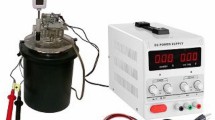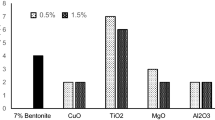Abstract
3D nanostructures, such as nanoparticles, it is the most used nanomaterial. However, 1D nanostructures such as nanowires (NWs) have equivalent properties that may use in several applications. In this study, the use of copper nanowires (Cu NWs) to improve the rheological of water-based drilling fluids is reported. The synthesis of the nanomaterial was conducted by redox reaction with copper (ll) salts. The morphology of Cu NWs has been observed using field emission scanning electron microscopy (SEM) and X-ray diffraction analysis (XRD). In addition, their bonding structure was studied by X-ray photoemission spectroscopy (XPS). The influence of Cu NWs on drilling fluid rheological properties was studied at different concentrations and different temperatures. The experimental results show that the interaction of Cu NWs with the drilling fluids resulted in a decrease in apparent viscosity (AV), plastic viscosity (PV), and yield point (YP) at 30%, and increase API fluid loss at 44%.
Graphical abstract





Similar content being viewed by others
Data availability
The datasets generated during the current study are available from the corresponding author on reasonable request.
Abbreviations
- NWs:
-
Nanowires
- Cu NWs:
-
Copper nanowires
- SEM:
-
Scanning electron microscopy
- XRD:
-
X-ray diffraction
- XPS:
-
X-ray photoemission spectroscopy
- AV:
-
Apparent viscosity
- PV:
-
Plastic viscosity
- YP:
-
Yield point
- API:
-
American petroleum institute
- NPs:
-
Nanoparticles
- EDA:
-
Ethylenediamine
References
D. Liming, Carbon Nanotechnology, 1st edn. (Elsevier Science, Amsterdam, 2006)
R.D. Booker, E. Boysen, Nanotechnology for Dummies (Wiley, New York, 2011)
S.S.P. Haghshenas, A. Nemati, R. Simchi, C.-U. Kim, Photocatalytic and photoluminescence properties of ZnO/graphene quasi core-shell nanoparticles. Ceram. Int. 45(7), 8945–8961 (2019). https://doi.org/10.1016/j.ceramint.2019.01.226
J. Altmann, Military Nanotechnology: Potential applications and preventive arms control (Taylor & Francis Croup, Abingdon, 2006)
T. Abdo Saleh, Nanotechnology in Oil and Gas Industries. Principles and Applications (Springer, New York, 2018)
N. Neuberger, H. Adidharma, Y.M. Fan, Graphene: a review of applications in the petroleum industry. J. Pet. Sci. Eng. 167, 152–159 (2018). https://doi.org/10.1016/j.petrol.2018.04.016
R. Caenn, H.C.H. Darley, Y.G.R. Gray, Composition and Properties of Drilling and Completion Fluids, 7th edn. (Kidlington, Cambridge, 2017)
R. Rafati, S.R. Smith, A. Sharifi Haddad, R. Novara, Y.H. Hamidi, Effect of nanoparticles on the modifications of drilling fluids properties: a review of recent advances. J. Pet. Sci. Eng. 161, 61–76 (2018). https://doi.org/10.1016/j.petrol.2017.11.067
V. Nam, D. Lee, Copper nanowires and their applications for flexible, transparent conducting films: a review. Nanomaterials 6(3), 47 (2016). https://doi.org/10.3390/nano6030047
American Petroleum Institute, Recommended Practice for Field Testing Water-based Drilling Fluids, 2n edn (1997)
J. Kim, J. Cui, Y.K.A. Fichthorn, Solution-phase growth of Cu nanowires with aspect ratios greater than 1000: multiscale theory. ACS Nano 15(11), 18279–18288 (2021). https://doi.org/10.1021/acsnano.1c07425
M. Ma, K. Djanashvili, W.A. Smith, Selective electrochemical reduction of CO 2 to CO on CuO-derived Cu nanowires. Phys. Chem. Chem. Phys. 17(32), 20861–20867 (2015). https://doi.org/10.1039/C5CP03559G
B.K. Singh, A. Shaikh, R.O. Dusane, Y.S. Parida, Copper oxide nanosheets and nanowires grown by one-step linear sweep voltammetry for supercapacitor application. J. Energy Storage 31, 101631 (2020). https://doi.org/10.1016/j.est.2020.101631
C. Sachse, N. Weiß, N. Gaponik, L. Müller-Meskamp, A. Eychmüller, Y.K. Leo, ITO-free, small-molecule organic solar cells on spray-coated copper-nanowire-based transparent electrodes. Adv. Energy Mater. 4(2), 737 (2014). https://doi.org/10.1002/aenm.201300737
M.C. Biesinger, Advanced analysis of copper X-ray photoelectron spectra: Advanced analysis of copper X-ray photoelectron spectra. Surf. Interface Anal. 49(13), 1325–1334 (2017). https://doi.org/10.1002/sia.6239
Acknowledgments
The authors would like to thank to the XRD laboratory headed by Dr. José Antonio Henao for his collaboration in taking the diffractograms. Microscopy Central Laboratory at PTG-UIS for your collaboration in taking the SEM and the surface science laboratory at Universidad Industrial de Santander for performing the XPS tests.
Author information
Authors and Affiliations
Corresponding author
Ethics declarations
Conflict of interest
The authors declare there are no conflicts of interest.
Additional information
Publisher's Note
Springer Nature remains neutral with regard to jurisdictional claims in published maps and institutional affiliations.
Supplementary Information
Below is the link to the electronic supplementary material.
Rights and permissions
Springer Nature or its licensor (e.g. a society or other partner) holds exclusive rights to this article under a publishing agreement with the author(s) or other rightsholder(s); author self-archiving of the accepted manuscript version of this article is solely governed by the terms of such publishing agreement and applicable law.
About this article
Cite this article
Díaz Izaquita, I.F., Ortiz Espinel, L., Santos Santos, N. et al. Copper nanowires as an additive to water-based drilling fluid. MRS Advances 7, 981–986 (2022). https://doi.org/10.1557/s43580-022-00422-z
Received:
Accepted:
Published:
Issue Date:
DOI: https://doi.org/10.1557/s43580-022-00422-z




